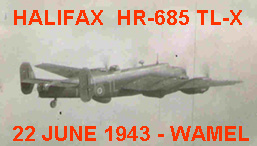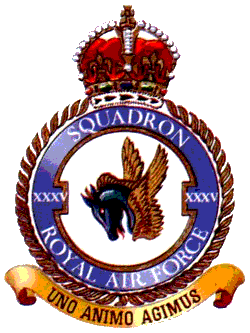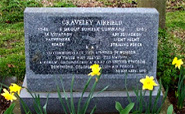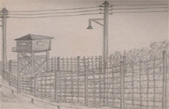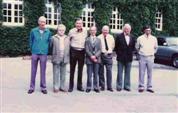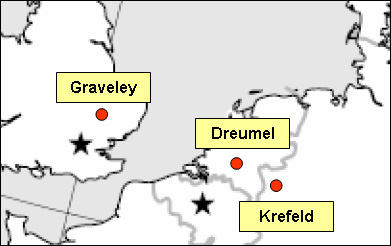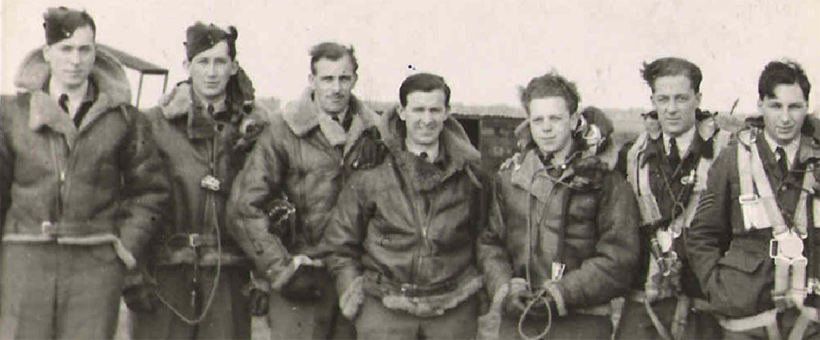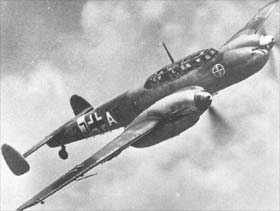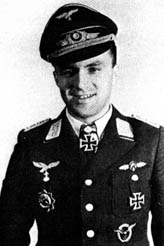|
 |
"The
nightfighter was at a great advantage as we were silhouetted against the
bright light and he could not be seen in the darkness. The rear gunner could
only fire at the fighter when he saw the gun flashes.
The rear
turret sustained a hit which disabled two of the four guns, and the
remaining two jammed, so we had no defenses and could not see the fighter in
order to perform evasive action. I remember looking out on the starboard
side and seeing shells ricocheting off the wing and exploding up ahead of us
when all of a sudden the port wing was engulfed in flames as the petrol
tanks were hit."
Contribution
Roy Macdonald, Mid-upper gunne |
| |
|
Meurer fired a new salvo and
hit the left wing between the engines. He flew at an altitude of 5500 meters
at that time. The Halifax trembled violently while at the same time the wing
set fire. It was 01.48 hours at that moment.
In the ensuing encounter
several incendiary cannon shells hit the port wing of our aircraft between
the port inner and outer engines, setting the' wing ablaze.
After
several unsuccessful attempts by the Flight Engineer to extinguish the
blaze, along with severe evasive action, the Flight Engineer and pilot
decided that the crew had to abandon the aircraft.
Tom Lane continues:
|
| |
|
|

|
"As
Captain (Skipper) of the aircraft I gave the final order to abandon
immediately as there was a serious danger of exploding in mid-air. I can
vividly recall my navigator and bomb aimer coming up from the front of the
aircraft and signaling me (thumbs up) that they were going out of the front
escape hatch along with the wireless operator.
My
mid-upper gunner heroically made sure that I had my parachute ready
hopefully for my safe exit from the aircraft. In the meantime my flight
engineer was still up to the last moment, trying to save our aircraft to no
avail.
The rear
gunner calld out "Skipper" over the intercom. indicating that he could
successfully bale out of the rear turret. Both the mid-upper gunner and the
flight engineer then indicated that they were leaving by the rear escape
hatch and also gave me the "thumbs up" sign. These events seemed to take an
eternity, but in reality were carried out very efficiently and effectively
by an experienced and courageous crew. I flew the damaged aircraft as well
as
possible
in order to allow the all the crew to abandon the aircraft safely. Under
these extreme circumstances the crew had, at all times, shown concern for my
well being and had made every effort' to ensure my safety.
Contribution
Tom Lane, Pilot |
| |
|
|
 |
"After we had been
succesful at Krefeld the plane was shot by a German nightfighter. When Jacko
(Jackson) opened the escape hatch life of the crewmembers changed completely.
An orange light illuminated two figures dissapearing in the dark. Tommy went
to the bombay while I was putting on my chute. Then it was my time to go too.
Jumping into the slipstream of the plane I rembered myself thinking: don't
forget to pull the tie."
Contribution Peter Balson, Wireless operator |
|
|
|
|
 |
"Mac (Roy
Macdonald ) Jacko (Peter Jackson) and I baled out of the front escape hatch
after being shot up by the German night fighter firing up from under us just
after Alec(Don Alexander the rear gunner)had raised the alarm Then Tom Lane
ordered all of us to bale out as the plane was on fire. We were at about
17,000 feet and I watched "X-Xray" spiraling in flames until it crashed. We
were within 10 minutes of the Dutch coast at this time!"
Contribution George Darling, Bombaimer |
| |
|
|
 |
"The Pilot
gave the order to abandon aircraft and I unplugged my intercom and went for
my parachute, returning to the side of the Pilot and plugging back into the
intercom. I could see down to the front hatch where the navigator and bomb
aimer were experiencing some difficulty in removing the hatch cover. The
engineer was standing behind me, not plugged into the intercom and kept
nudging me to hurry up and get out, whilst I was trying to indicate to him
that he had to hang on a minute.
I then
watched the navigator, bomb aimer and wireless operator disappear through
the hatch and turned round to tell the engineer that we could go, only to
discover that he had got fed up waiting and had gone to the rear of the
aircraft where he had used the main entrance door, as had the rear gunner. I
was on my to the hatch when I heard the pilot say that he couldn't find his
harness clip, so I went back and pulled out his release clip and then exited
the aircraft."
Contribution Roy Macdonald, Mid-upper gunner |
| |
|
|

|
"My next
task was to trim and stabilize the aircraft and then attempt to leave by the
front escape hatch. This entailed getting out of the pilot's seat and then
down below to the front escape hatch. As I was exiting this hatch my
parachute partially opened and I tore my leather gauntlets to shreds in
getting out.
The
parachute opened fully almost immediately and I can still see the tail wheel
of the aircraft passing above my head. I then followed the flight of our
burning Halifax bomber until it crashed to the earth.With
all the hectic evasive action and the crew activity within the aircraft I
probably baled out at roughly 16-17.000 feet at about 1.30-2.0 am.
(At our
crew re-union in 1983, Don Alexander confirmed with me again - as he had
done in Prison camp - that he was certain that he had successfully hit
the attacking aircraft and that it had to have been seriously damaged.)
Contribution Tom Lane, Pilot
|
| |
|
|
Tom Lane is confirmed in his
thoughts by a citation from the book "Airfield Venlo part 2" written
by Jan Dericx in which it says: "The Bf110 G9 + BL
of Manfred Meurer and Feldwebel Scheibe was during airfights damaged so
severely that both crewmembers decided to abandon their aircraft . The
nightfighter crashed near Elsendorp....." (in the Peel, province of
North Brabant) |
| |
|
|
Jan Derix also states that Hauptmann Hans - Dieter Frank
shot a Halifax at 01.38 hours. the plane crashed at Wamel. Two crewmembers
were killed which ofcourse is wrong! The Abschussliste also states that
Hauptptmann Frank at exactly the same time shot another Halifax that crashed
1 kilometer west of Veghel. |
| |
|
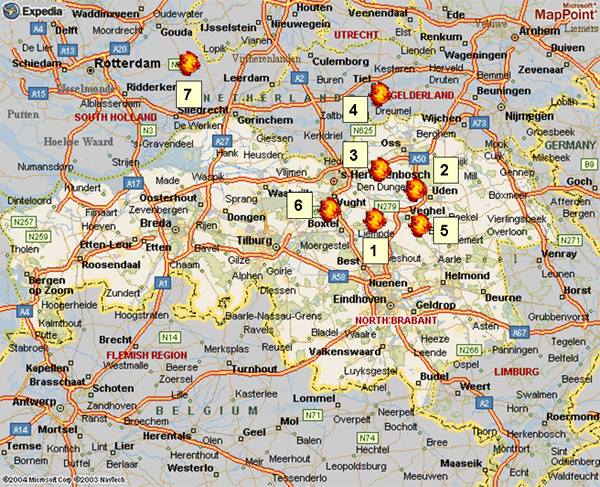 |
| This map
shows at least 7 crashes
in the night of 21 to 22
June 1943. Number 4 indicates the location at Wamel. |
| |
|
|
|
3. Between heaven and earth |
Within ten minutes live of
the crewmembers changes completely. The relative safe secutiry of the plane
changes into an uncertain future when succesfully Jackson, Darling, Balson, Alexander, Rogers,
Macdonald and Lane leave the Halifax.
For a moment they are in the slipstream of the instable plane. Then the
parachute slows down the speed. Descending starts with 1000 feet per minute.
It will take 18 minutes before they will hit the ground. |
| |
|
|
|
The
crash of the Halifax |
|
At an altitude of 6000 meters
Lane and Darling follow the burning airplane in his last meters. Darling
states that he saw the plane "spiralling down". Skipper Tom Lane sees the
crash of the Halifax. They are not the only ones.............
Citation of the wardiary of Mr. J. van
Olderen from Tiel. (He lived directly opposite the ferryhouse in Wamel) |
| |
|
Thuesday
June 22 1944
Many planes this night fly over oiur area between 01.00 and 04.00 hours. At
01.55 hours I woke up from heavy shooting. I looked out of the window and
saw a lot of fire in the air. At 02.00 hours a plane was hit. It flew at a
very low altitude above the city of Tiel. As a big fire ball it made a
cirkel, then for a few seconds it flew straight and then slowly descended
vertically on earth.
Our first thought was that it would hit our house, but
happily it fell on the opposite site of the river Waal. Directly we ran upon
the dike and saw a fvery strong fire flash.
Duriong the next twenty minutes we heard the sound of explosions.
(ammunition). By that time it was a quarter to three and there were hundreds
of people on the dike looking at the fire. When we saw a policeman we
quickly went back to our houses. I saw five planes crash that night." |
| |
|
|
Another inhabitant of
Tiel, mr. Holst has also recollections of that night.......: |
| |
|
|
“I saw the plane coming from
the direction of Ochten. This was very remarkable because most of the times
planes flew across the province of Brabant. The plane followed the river
Waal and then turned to Wamel. When it hit the ground a big fireball became
visable. The next day we went to have a look. The plane had crashed in a
pasture behind a farm." |
| |
|
|
A lot of inhabitants of Wamel
witnessed the crash of the Halifax. In the Dorpstraat, the main street
of the village, baker Willy Looman and his neighbour Sjaak Bokken are asleep
when through the wideopened windows in this warm night the sounds of an
airplane catches their ears.
"What's going on, Sjaak?" the
baker asks with his heavy sounding voice. Both men get out of bed and put their head
through the window. They see the plane like a large fireball flying across
the village. For a short moment they think they are in danger, but the
Halifax continues flying........ |
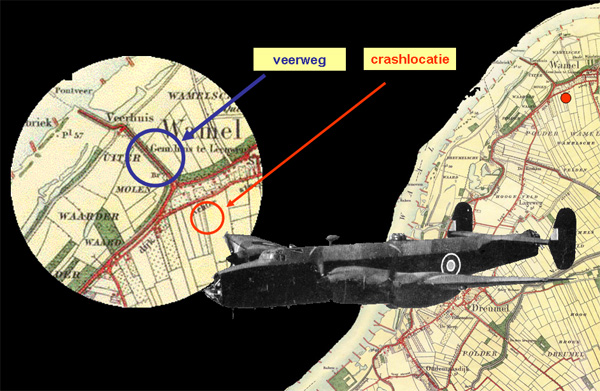 |
|
| |
|
|
Some streets further, in the
Achterstraat (now Viaductstraat) are a copule of small houses, built after
the flood in 1926. Here people have heard the sound of the approaching
airplane too. Father
and mother Gerritsen get their children out of bed because airfights are
going on and as the small house has no cellar,they by force of circumstance
go to the street.
Ten year old Wil Gerritsen
and his three years older brother Ad see the passing Halifax that night. At
this moment the whole plane is on fire.
At an altitude of 100 meter
the burning plane passes their house. They run to the back of their house
and see the plane crash. Wil expects a gigantic
explosion, but .......... but the only thing he hears is some crackling and
exploding ammunition. |
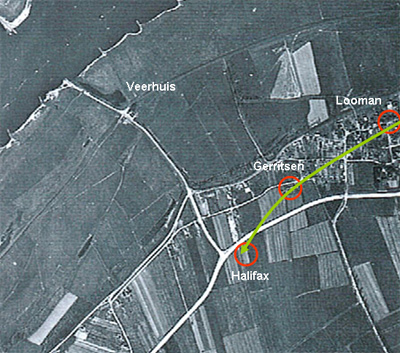 |
| |
Aerial picture of Wamel in 1950 with crashlocation of the Halifax;
Baker Looman en Wil Gerritsen both saw the plane flying over their houses
|
|
| |
|
|
|
Somewhere in the air space above the polder of Wamel…. |
|
The crew now is in the air space above the polder of
Beneden - Leeuwen en Wamel. With a speed of 1000 feet a minute the seven
crewmembers descend with their white parachutes. Panic and hectic have
changed places with total silence. Everyone now is on its own.
Uncertainty takes possession of them and they think about what they can
expect after landing. Undoubtedly also recalling the last minutes in the
Halifax……. |
| |
|
|
 |
"My first
impression was of the complete and utter silence, broken only by the gentle
sighing of the wind through the shroud lines of the parachute. This rather
tranquil state was then rudely interrupted by a Lancaster bomber returning
home which passed by so close that I could see the faces in the cockpit and
was left swinging wildly in its wake.
I could
not help but wish that they could have hooked on to me and towed me home. At
this time I think we had been at about 17.000 to 18.000 feet and so in the
bright moonlight one had little sense of falling and seemed to be hanging in
space. I was facing the north star which was clearly visible and twisted my
parachute straps in order to look around, and was amazed to see another
parachute some distance away.
I shouted
and he could hear me and asked me where I was to which I replied "on your
west" and he shouted back that he could see me and to try and stay in
contact. This was Jim Rogers, the engineer.
Nothing else of importance occurred until I landed in a field of grass,
after something like fifteen to twenty minutes in the air."
Contribution Roy Macdonald, Mid-upper gunner |
| |
|
|
 |
"As I floated towards the earth, I could hear
other bombers returning to their home bases in England if lucky, and
thinking how alone I was, and how unlucky. The truth is that I was the
fortunate one - I'm a survivor! In the full moonlight from that altitude I
could clearly see the coastline of Holland and a huge expanse of water.
Being a non-swimmer the thoughts of possibly parachuting into this water
momentarily terrorized me!
Many thoughts obviously pass through one's
mind as you float down (are suspended) quietly and effortlessly through the
air. As you approach the ground surface it suddenly darkens as you lose the
direct moonlight and you land abruptly and hard, but thankfully, on the soil
surface. This landing was in a pasture field and a frightened white horse
bolted away, making a ghostly appearance to further shatter my nerves."
Contribution Tom Lane, pilot |
| |
|
|
|
The polder of Wamel |
|
Tuesdaynight Juni 22, appr.
02.00 hrs |
|
The crew members in the end
succesfully succeede in bailing out safely. Another problem was to survive
the landing. In fact everyone was parachuting for the first time and curious
to find out where one would land. |
| |
|
|
The first crew member probably
bailed out somewhere above Boven - Leeuwen, while the last one, Tom Lane,
left the plane somewhere above Beneden - Leeuwen and Wamel. Because of that
the crew members scattered around in the polder area betwee Beneden -
Leeuwen and Wamel.
It was appr. 02.00 hours when
Tom Lane being the last one, landed. This time is rather precise bacause the
plane according to the German Abschussliste was hit at 01.48 hours by Hauptmann Manfred Meurer.
Mr. Van Olderen wrote that the Halifax flew above the city of Tiel at 02.00
hours. Roy Macdonald rembered that the time between the hit and the last one
baling out was at the most 10 minutes. |
| |
|
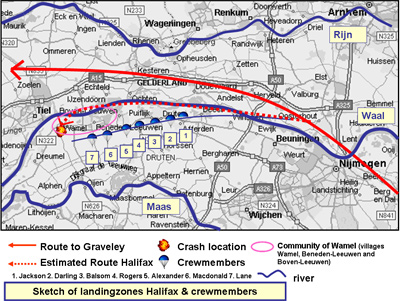 |
| |
|
|
Not everyone did have lucking
landing. Peter Jackson had a contused ankle. Peter Balson ended up
with a broken ankle........ |
| |
|
|
Both Jackson and Balson are
forced to stay at the landingzone and wait for the moring to come. Tom Lane
decides to do the same. Darling,
Alexander, Rogers en Macdonald hide their parachute and set off to the
inhabited world. The last one -
looking at the pole star – decides to go southwest. |
| |
|
|
 |
"Nothing
else of importance occurred until I hit the ground, after something like
fifteen to twenty minutes in the air. I was in a field of grass, no idea
whether I was in Germany or Holland, and quite expected German soldiers to
pounce on me from all directions, but all was peace and quiet so I bundled
up my 'chute and stuffed into a ditch and took stock of the situation.
I could see the Pole star quite easily so decided to head south-west as that
should take me towards Belgium where there was reputed to be a good escape
"pipeline". I reached the edge of the field in a few minutes only to find it
was bordered by a wide ditch. |
| |
|
| |
|
I wasted a
lot of time looking for a bridge which turned out to be a plank of wood on
the east side of the field, so I went back to the south west side and tried
to jump the ditch, only to fall short and went into the water. It was about
chest deep and I crawled up the other side with my battledress blouse
ballooning out with water, so, being thoroughly wet, I just lowered myself
into the following ditches and just waded across.
I crossed
a cornfield and as I approached the far side I could see through the low
mist a line of trees which seem to indicate a road of sorts. At the same
time I heard a sound of footsteps which led me to believe that there was
some sort of sentry pacing up and down.
I lay down
in the corn, listening to creatures rustling about, but the footsteps seemed
to be stationary, as though someone was marking time. I crept slowly towards
a hedge which was between me and the sound, and to my surprise found it was
a cow chewing the cud! |
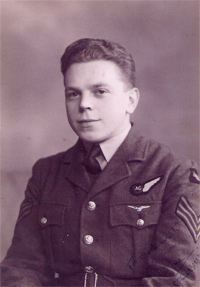 |
| |
|
|
| |
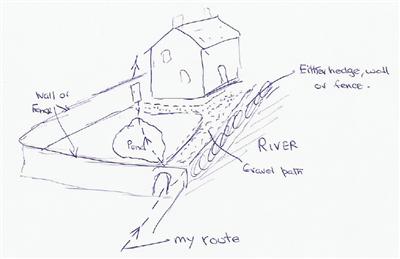 |
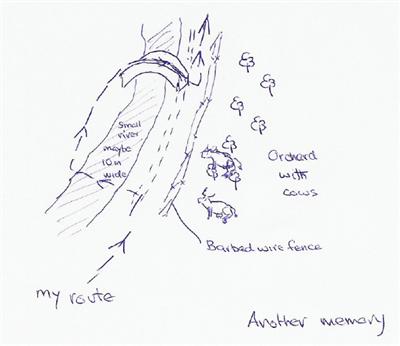 |
|
Drawing 1 |
Drawing 2 |
|
More then 60 years later
(2004) Roy Macdonald made two sketches with memories of that night. |
|
| |
|
| |
I carried
on across the road and seemed to be endlessly in and out of ditches, and was
thankful that it was a warm night. At one time I came across a small post
about three feet high with a crossbar, both painted white, and on the
crossbar was painted a notice which, to my uninformed eye I seem to
recognize as Dutch, which at least told me which country I was in.
Another vivid recollection (see drawing 2) is of walking alongside a
waterway, maybe about thirty feet wide on my left, and what appeared in the
moonlight to be an orchard on my right. All of a of a sudden I heard the
thundering of hooves, and two large shapes appeared heading towards me at
high speed. Not wishing to argue with the unknown, I simply dived into the
water and swam to the other side where I walked up the other bank only to
find a small bridge about thirty yards from where I'd dived in!!
Crossing to the original side I could see the two mysterious shapes standing
still at the side of the road where I'd been. Wondering why they hadn't
bothered to chase any more I walked forward and discovered a barbed wire
fence which had been between me and what I found to be two inquisitive
cows!!!
My next
vivid memory
(see drawing 1)
is of walking alongside a large river which was on my right hand side. By
this time I had been walking for some three hours and was getting a bit fed
up.
I reached
the boundary wall or hedge, I can't remember which, of a large house. Why I
couldn't go round it to the left I can't remember, but I went through a door
into the garden which fronted on to the river. From the door, a gravel path
led across the garden and the front of the house, and where it met the house
it branched left along the nearside of the house to what appeared to be
another door in the boundary. Not wanting to make a noise crunching over the
gravel to get to the other door posed a problem as a large lily pond lay
between the two doors! Being soaking wet already, I therefore lowered myself
into the lily pond, and waded across and got through the other door."
Contribution Roy Macdonald, Mid-upper gunner |
| |
|
|
George Darling too decided to
make his way. It is not known where exactly he went...... |
| |
|
|
 |
"I landed
in a field none the worse for wear, and started walking ( it was a night of
a full moon), crossing over a flooded ditch about 5 feet wide. After about
an hour or so I saw a small farm cottage and decided to knock on the door. A
man answered the door, saw my uniform and let me enter. He said a few words
to his wife, indicated for me to stay where I was, and went out.
He
returned shortly, maybe about half an hour, accompanied by a middle-aged man
who spoke a little English. He told me he was taking me to another house in
the village which was called WAMEL. It was a big house full of people.
Someone left the house and I assumed that he had gone to get in touch with
the Resistance. I could not have been more mistaken as, shortly after, the
door burst open and two heavily armed German soldiers entered and ordered me
to get into the sidecar of their motorcycle. They drove me down the road,
passing some German transport vehicles, until we arrived in the village or
small town of Tiel, where I was put into the goal. Later in the same day, I
was transferred to Nijmegen by car which had arrived containing Roy
Macdonald."
Contribution George Darling, Bombaimer |
| |
|
|
There is not much to tell about Don Alexander.
this is his story………….. |
| |
|
|
 |
"I do not know
where I landed nor in what village I ended up. I came at a house and
apparently was offered help by a woman. She
provided me with the change of clothes: a
blue pullover and a pair of dark trousers with a faint silver stripe in
them. I was just having a shave when the police came for him. Obviously
someone had informed on me being there.
the next time I met Roy
Macdonald, Jim Rogers, we were
in the Feld Polizei Office in Njimegen."
Contribution
Don Alexander, rear gunner |
| |
|
What Alexander didn't tell is
that he enterd the office with under his arm a box of cherries.
June has always been the month
that the cherry harvest took place. We will see that later on in the story
of Peter Balson. It is possible that Don Alexander ended up with mr. van
Hoeke, the local doctor of Wamel.
In the local newspaper,
De Gelderlander, a couple of years ago there was a story about the war.
Doctor van Hoeke tells about meeting an "airgunner". The widow of doctor van
Hoeke does remember that one summerevening the doctor came home with a "pilot":
"It was a very warm summer evening and we were eating cherries together
with this pilot." |
| |
|
|
here is no information about
Jim Rogers. The only recollection is recorded by Roy Macdonald…….. |
| |
|
|
 |
"When
I received the statements of the crew members Jim Rogers already had passed
away. But I remember that he once told me about a man that rowed him across
the river and was brought to Tiel where the germans picked him up.
Nevertheless it is strange that we were in touch when parachuted, but lost
contact after landing."
Contribution Roy Macdonald
about Jim Rogers |
| |
|
|
-0-0-0-0-0-0-0-0-0-0-0- |
| |
|
|
Tuesdaymorning
June 22 |
| |
|
|
The crashlocation of the Halifax |
| The Germans that
were stationed in Tiel crossed the river in the early morning of June 22nd,
1943. One group of soldiers was ordered to guard the wreckage and others
started a search in the pasturefields to find the crewmembers.
Willy Looman, the local
baker whom we met before, was delivering bread with his horse drawn weagon
in the Liestersteeg. In the distance he saw a big group of soldiers. But he
thought the Germans held a big exercise. At that time he didn't think of the
plae that had crashed.
The local people of Wamel visited the crash location far more earlier then
the Germans. They saw that there was no crater. This confirms the idea that
the Halifax had landed like a glider on the land of farmer van der
Wielen. The wreckage was situated on the border of plot 246.
Frans van Oijen is is a an amateur historian in Wamel. He spoke to many
people and made tape recordings of these conversations. This is what his
recollections are.......... |
| |
|
"Half the village
visited the wreckage that early morning. They hoped to find something of use.
My father for instance took some plexiglass of which he made a ring.
Unfortunately I lost it. My neighbour also to plexiglass. Other people
took the canvas of the chairs of which they fabricated portfolios. Mr. Jo Janssen
at some distance found a wheel. He hid it in a small forest opposite the
house where the Udo family now is living.
Wil Gremmen and his
brothers performed something extraordinary. One of the engines obviously
fell of the plane before the crash and was at some distance of the wreckage.
It was about 3 meters down into the clay. They arranged to get it out and
hid it in a nearby ditch. I do not know what happened with the engine
afterwards.
Some years ago I had a
conversation with mr. Holst from Tiel. He saw the crash that night. The next
day he and a lot of other locals from Tiel crossed the river by ferry in
order to find some "souvenirs". He encountered some Germans with a horse
drawn weagon with some wreckage parts on it. the crash location was empty by
then and he didn't find anything left. Mr. Has Thijssen was a twelf
year old boy at that time. When he arrived at the crash location later that
day he saw some German soldiers on guard." |
| |
|
|
Wil Gerritsen, living close to
the crash site does not remember if he visited the wreckage. But he has this
recollection...... |
| |
|
|
"My older brother Ad
found a little watch. He took it home and when doctor van Hoeke once visited
them he showed him the watch. the doctor thought it had something to do with
bombs. somewhat later the family handed the watch over to the doctor.
|
| |
|
We go back once again to the
plexiglass Frans van Ooijen was talking about. Will Gerritsen states:
“Mr. Toon Burgers was the local blacksmith.He made rings out of the
plexiglass. In the ring he made three little holes that were filled up with
red, white and blue paint!" |
| |
|
|
The Gerritsen brothers Wil and
Ad saw at least one but maybe two crewmembers that were taken prisoner:
|
| |
|
|
"The next day (June 22nd)
a group of german soldiers passed the Achterstraat with 1 or 2 POW' s. In
total there were five people leaving the farmhouse of mr. van der Wielen and
heading towards the village. The prisoners made a Victory sigh to the people
that stood along the road." |
| |
|
|
But let's go back to the
statements of the crewmembers. Because of his wounds Peter Balson was forced
to stay at the landing zone, hoping that someone would help him.......
|
| |
|
|
 |
"
My next memory is of a large grey farm horse sniffing about me! I soon
realized that something was wrong with my right foot, so dragged my
parachute over me to protect me.
It
was a bright moonlight night and I could see cattle nearby across a ditch.
As dawn broke, I saw a two wheeled farm cart approaching the cattle so I got
to my feet, whereupon the driver of the cart turned about and sped off - as
was he Ben Hur - to a village visible among the poplar trees."
Contribution Peter Balson, Wireless operator |
| |
|
|
This man was farmer Jan Sengers
from Beneden-Leeuwen…. |
| |
|
“In 1943 Uncle Jan
lived in a big farmhouse at the corner of Zijveld and Zandstraat in Beneden - Leeuwen.
He had been a student at the seminar for some years so he could speak some
English. It was common that uncle John every day at 07.30 hrs went to milk
his cows in the polder with his wheeled farm cart. At the end of the Zijvond
he turned right and drove upon the rampart along the canal. there he saw a "pilot".
He waved with both arms and made the victory sign. He brought the pilot to
the townhall in Beneden-Leeuwen."
Contribution Sengers family , Beneden-Leeuwen |
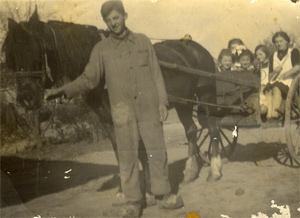 |
|
Mr. Martien Walraven from Beneden-Leeuwen
has another recollection: |
Jan Sengers with his horse and
wheeled farm cart |
|
| |
|
“I was a boy of 15 years at that time. My parents did not
tell me mutch about what was going on. In the morning my brother came home
from the cherry orchard to get some sandwiches for a "pilot" he had found in
the orchard.
After some time I cycled to the orchard to have a look. Somewhere halfway I
met Jan Sengers with his horse drawn weagon. On the cart was a wounded pilot. Jan
stopped and we had a chat. The pilot was eating from a small scale
with cherries. He told us that he had the feeling "as if he was back home in
Australia. It was the scale he had received from my brother."
Contribution Martien Walraven |
| |
|
|
 |
"Within what seemed just a few minutes a large number of people approached
from the village which subsequently turned out to be called Wamel.
(Must be Beneden - Leeuwen JVK) Amongst the people was a doctor who gave me
expert attention on my foot It might well have been Dr. Van Hoeke (must be
doctor van Haagen JVK) and after that we all returned to the village
hall where a cheering crowd gave me an enthusiastic welcome and a wonderful
breakfast of bacon and eggs!
During
this time, a young lady, whose name I believe was Wiekie
(Mevr. Wieke de Vocht-Baltussen JVK),
acted as interpreter. She informed me that the police were on their way, and
in fact they arrived within an hour.
I would
like to take advantage at this time to thank the good people for their
generosity and great support and kindness to me at this rather traumatic
time."
Contribution Peter Balson, Wireless operator |
| |
|
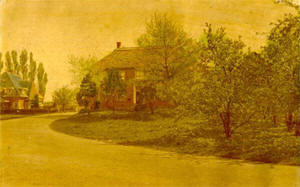 |
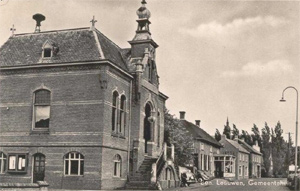 |
|
Farmhouse of Jan Sengers |
Townhall in Beneden - Leeuwen |
| |
|
|
|
Mrs. Wiekie de Vocht – Baltussen
remembers this meeting very well: |
| |
|
|
"The boys of the
resistance had brought mr. Balson to the prison in the townhall and held him
there. In those days mr. Haver was policeman in Beneden – Leeuwen. My
father was a notary and a daugther of this policeman worked for my parents.
Mr. Haver was a very reliable person and he always warned my family when the
Germans undertook some action.
I was befriended with Ien van Haagen, the eldest daughter of doctor van Haagen,
I went to see mr. Balson and spoke with him for some time. I do not know
what has happenede to him afterwards. I think doctor van Haagen has visited
him to have a look at his ankle.
After the war I stayed
regulary in touch with mr. Balson. This all had to do with the fact that my
brother Lou emigrated to Australia and met him there." |
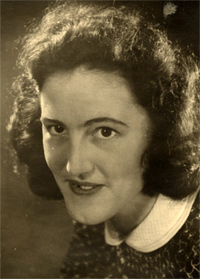 |
| |
Wiekie
Baltussen - de Vocht |
|
|
Another crewmember depending
help from the locals was Peter Jackson…… |
| |
|
|
 |
"After
baling out of the aircraft, I landed very heavily in the dark and hurt my
right ankle. When it became light I found I had landed on the edge of a corn
field, and when the workmen arrived I got in touch with them.
When they saw that I could hardly walk, they fetched an old horse drawn van
and took me to the nearby village. They then called in the local doctor who
looked at my foot. He thought that it was a bed sprain and bandaged it. He
also informed me that unfortunately they could not help me to escape, as the
German army had men watching the river crossing. As a result, they had to
report my appearance".
Contribution Peter Jackson, Navigator |
| |
|
|
Mr. Has Thijssen from Wamel
lived at the corner of the Liestersteeg at that time. (Now Parkenstraat) He
has a recollection of an event from that time that fits in very well in
Peter Jackson 's story......... |
| |
|
|
"Together with my
grandfather I went into the polder one day after the crash. We went looking
for crewmembers allthough I didn't know that at that time as I was just a
boy of ten years old. somewhere near what nowadays is called the
Hoevenstraat I saw an Englishman hidden in the corn. Probably grandfather
saw the man too but he just pretended he had not seen anyybody. I do
remember that he brought me home. I suspect that my granddad went back later
that day and that he has brought the man to doctor van Hoeke. Obviously the
news was spread very quick b ecause the man was picked up later that day. |
| |
|
|
Granddad picked up the
parachute and hung it on the hay attic . He put away the ladder in orsder to
prevent that others would take a look. When we moved to another house the
parachute was thrown away.”
Apparently mr. Has Thijssen
returned to the polder too late because Peter Jackson was already gone. Baker Willie Looman
whom we met before, took him away…….
“The next morning I was
delevering bread in the polder. When I was in the Liestersteeg near the
house of the Beck family I saw an English pilot. I transported him back to
the village. On my way home I met police van Wijk. He was a collaborator."
"Looman told him that
he was intending to deliver the pilot at the office of policeman Springer.
this officer talked to Jackson almost the whole day. There must be a
photograph of this pilot somewhere in the Looman family. In the evening
Jackson was taken away."
Videotape 1992 baker Willie Looman
|
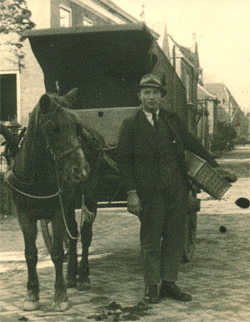 |
| |
Baker
Willie Looman |
|
| |
|
|
Five crewmembers are arrested by
now and handed over to the germans. Tom Lane hid himself the whole day in
the cornfield and waited until it waould be evening again. Roy Macdonald is
still underway. Hij is by now had passed the cafe "Het Schutlaken" (situated
in the middle of the polder) and is walking in the direction of Dreumel…… |
| |
|
|
 |
"By this
time it was getting light, and I wondered about trying to hide up somewhere,
but the countryside was so open and bare it seemed rather hopeless, and I
decided that I would have make contact with a local and hope for the best. I
eventually came to a farm and banged on the door and yelled until an old man
stuck his head out of a bedroom window.
I shouted
all sort of things at him such as "R.A.F…..English…......................................
Aviateur Anglais", at which he looked more bemused and indicated for me to
wait for him. He came down some minutes later having got dressed and came
out wheeling his bicycle and beckoned me to follow him.
At that
time I was carrying a large service issue clasp knife, but also had a scout
sheath knife down the side of my flying boot. Along with pointing with my
finger I said to him: "You…me…Police?" at which he shook his head, so,
wishing to get the point across, I repeated the question, followed by "Me
…you..." and gestured with the sheath knife, which I hoped would ensure that
he got the message. He again shook his head and beckoned me again and we
walked on, eventually coming to the outskirts of a village called Dreumel.
It was very quiet and I saw no-one about.
I did
notice however whilst turning a corner, there was a small card in the window
of a house on which I was surprised to see the word "Hairdressing" written
in English! I often wondered whether that would have been a better place to
contact. Anyhow, we walked on, past the village church to a small house
where the farmer knocked on the door and to my dismay it was opened by a
policeman! Needless to say, the farmer vanished!! |
| |
|
| |
|
The policeman and his wife were kindness itself, and
sat me down and made a much appreciated breakfast
and coffee and produced a dry pair of socks and an
old pair of black shoes so that I didn't have to
stay in my soaking wet flying boots. They gave me to
understand that they had sent for someone who could
speak English, and he duly arrived, the tallest
policeman I have ever seen, wearing a stovepipe hat
which made him look enormous.
He was very nice and friendly and asked what he could
do for me. I produced my silk map and asked him to point out where I was,
which he did, and then I told him that I wanted to get to Belgium. "Oh, you
wish to leave" he said, "but we have rung up the Germans and told them you
are here!". At that, I gathered up the map, picked up my boots, and made to
leave. |
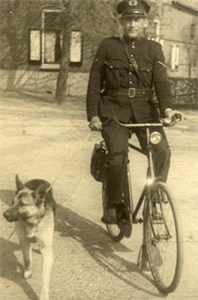 |
|
At this,
the tall policeman stopped me and said "I'm very sorry, but you can't go
now. The Germans know you are here and will come for you, and if you are not
here they will take twenty men from the village and shoot them." |
Policeman Leenders |
|
| |
|
| |
I then
asked him why he had told the Germans that I was there, to which he replied
"If you could have reached us without anyone seeiing you, we could possibly
have helped you, but the old farmer has seen you, and when the soldiers come
looking for the crew of the crashed airplane, the old man being very
frightened, as are all the old people, is sure to tell them that you have
been here and there will be shootings!" There wasn't much I could say after
that, and sadly realized that my bid for freedom was over. |
| |
|
| |
|
He
then took me down the garden, through a gate and into the
Burgomaster’s office in the little Town Hall. The Burgomaster had
been summoned and was also very nice, rolling me a cigarette in a
most ingenious little machine. He asked me where we had bombed but I
declined to say, and then he shrugged his shoulders seemingly
understanding my reticence and said that if I gave him my home
address they would try to get a message to England to say that I was
safe. As prisoners of war wrote home anyway, I didn't see any harm
in giving him my address, but they never managed to notify anyone
after all. |
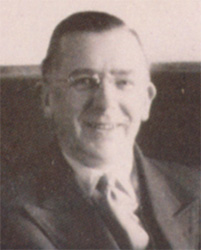 |
| |
Burgomastar Waals |
|
| |
|
| |
|
I was
sitting in a chair at the opposite end of the room to his desk, and was next
to the hinge side of the exit door, through which, after about twenty
minutes, barged in two German Field Police wearing crescent shaped metal
insignia hanging from their necks on chains. The door being now open, I was
virtually hidden by it, and the two Germans walked straight over to the
Burgomaster and shook hands in greeting, and I thought "Good Lord", they're
all old pals!!" (being quite ignorant of the Continental habit of everyone
seemingly shaking hands with all and sundry all the time)!!.
They must
have asked him where the airman was, as he suddenly pointed towards me,
whereupon they both turned round and uttered some sort of excited roar, and
as they both looked like prizefighters as they advanced towards me, a
feeling of trepidation crept over me. The ugliest one said "How many motor
you plane have?", to which I shrugged my shoulders and said "I don't know",
then came "What town you bomb last night?" which got him another shrug and
an "I don't know", at which he roared "Schweinhund", grabbed me by the arm,
took me out onto the road and into the back of a car helped on by a boot up
the backside.
Contribution Roy Macdonald, Mid-upper gunner |
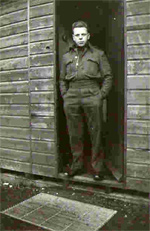 |
|
Roy
at Graveley |
| |
| |
| |
| |
|
| |
|
-0-0-0-0-0-0-0-0-0-0-0- |
| |
|
|
Thuesdayevening
June 22nd |
|
Pilot Tom Lane by then is the
only one left in freedom. He has spent the whole day in the cornfield and
valued his chances......... |
| |
|
|
 |
"Recovering from my landing, I realized that a corn (maize) field was beside
the pasture field and I immediately folded up my parachute and concealed
myself in the cornfield, where the corn at that time of year was several
feet high.
I spent
the daylight hours of June 22nd hidden in the cornfield and watched as a
woman milked several cows in the pasture field, both in the morning and late
afternoon or early evening. Whilst the pasture field and corn field were on
level ground, the farm buildings were on much higher rolling topography. |
| |
|
| |
|
I
decided that I would wait out the daylight hours in the cornfield and go to
the farm house for help after complete darkness had fallen. I carefully
approached the farm undetected and knocked on the farmhouse door. The
surprised occupants (3) waved me into the house.
They
spoke no English but certainly knew that I was a foreigner in some sort of
uniform. Very shortly afterwards the man and either his son or hired help
(or forced labour ?) appeared each carrying a rifle and the woman then got a
hayfork from the barn.
Without any hesitation (or consideration) f they then forcibly marched me
some distance to a village. |
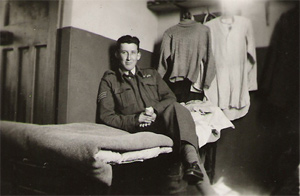 |
| |
Tom Lane in 1942 |
|
| |
|
| |
When we
entered into what seemed like a town hall. several of the local inhabitants
soon congregated there. I was somewhat of a welcome/unwelcome celebrity.
There was no escape! I have no anger, no resentment at the farmer, nor his
wife, for turning me over to the German authorities. Their lives were more
in danger than mine if caught aiding a "Terror Flyer"!! The Police soon
arrived and I was located in the local police lock-up overnight. |
| |
Contribution Tom Lane, Pilot
|
| |
|
|
It is not clear in which village
Tom Lane eventually was arrested. Probably it was in Dreumel. It is very
special that he was brought in by armed locals. Durinng the occupation all
people were ordered to hand over their weapons to the authorities. The
Germans handed the guns over to the NSB - collaborators. They very often
paraded in the streets to provoce the inhabitants. In Dreumel were a lot of
collaborators at that time. Most of them had chosen to do so because of
poverty.
Being the last one bailing
out the plane it is logical that Lane landed west of Roy Macdonald. As
Roy ended up in Dreumel, it is most likely that Tom Lane ended up there too. |
| |
|
|
|
|
|
